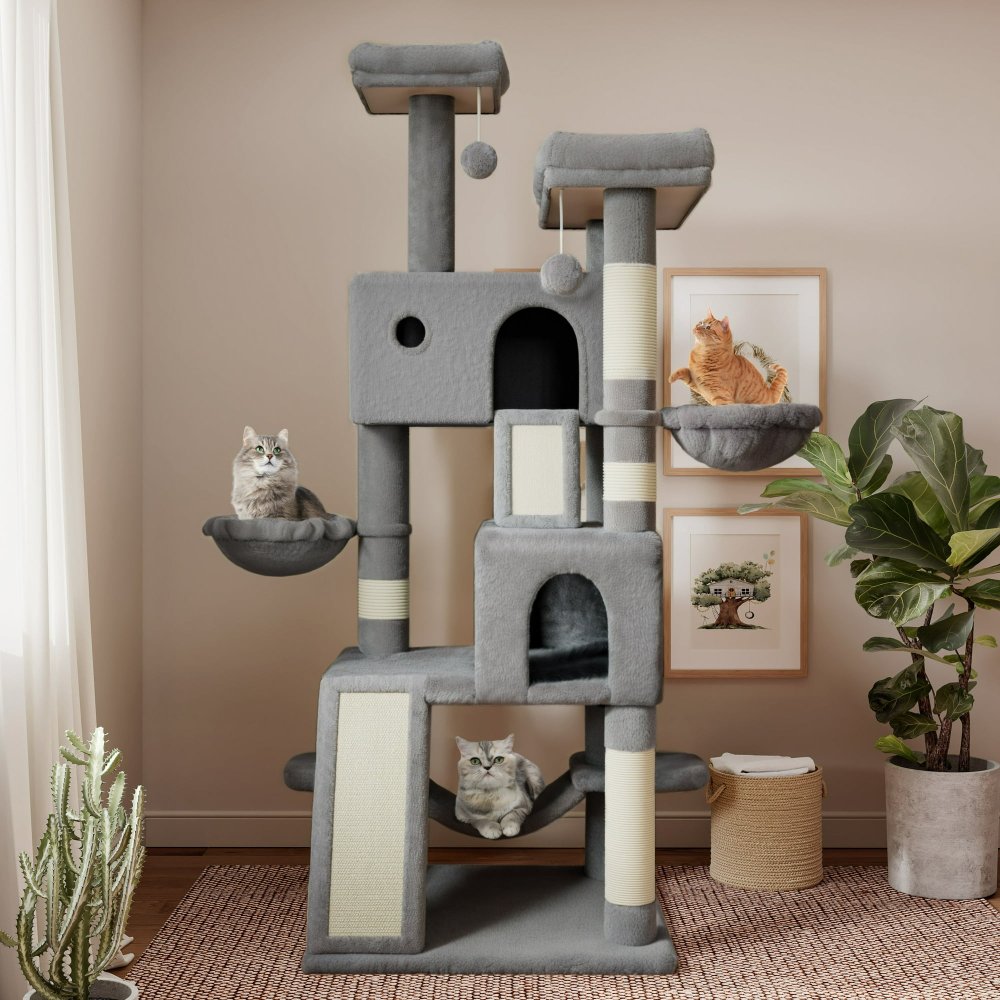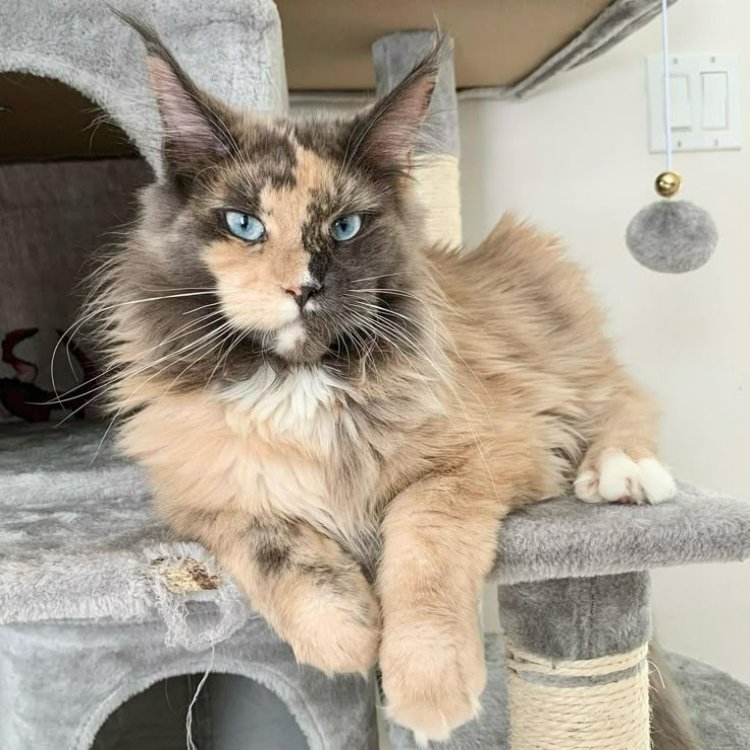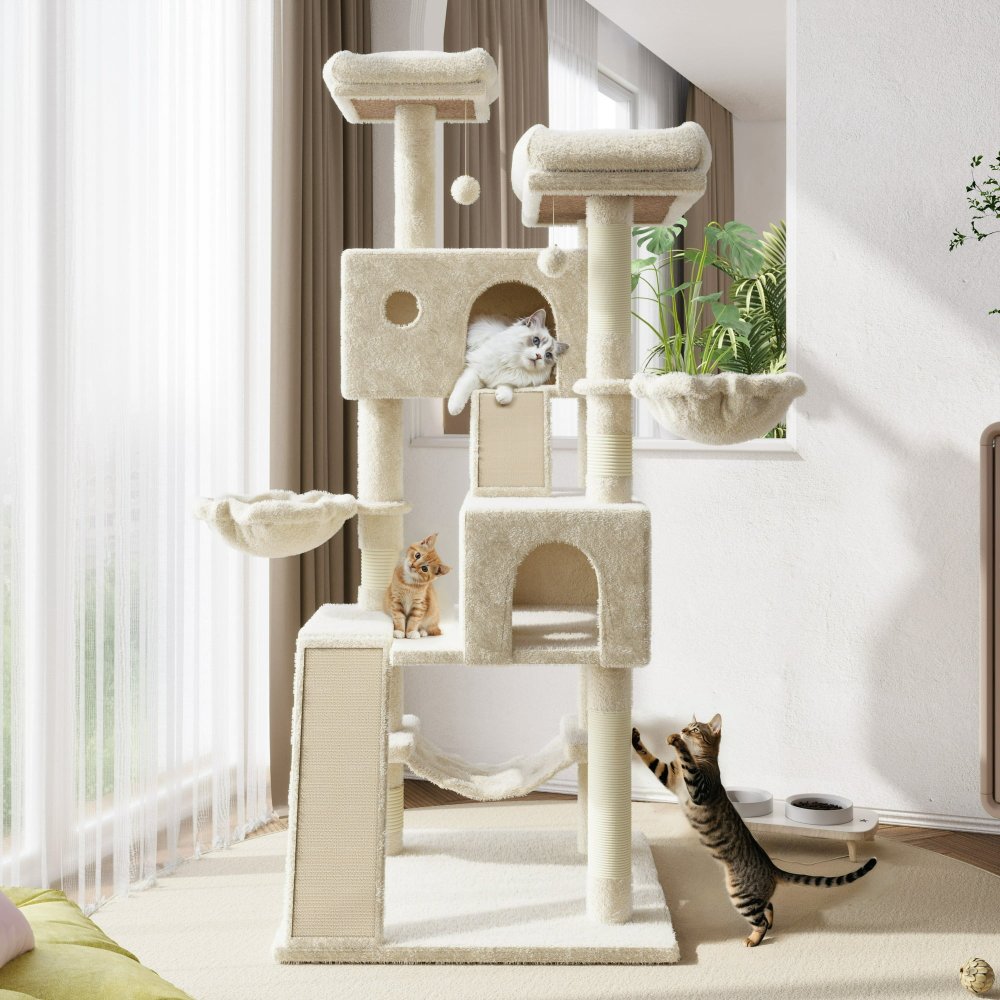Why Choose Carpeted Cat Trees
Choosing the right cat tree can make a big difference in your cat’s life. Carpeted cat trees offer several advantages over their bare counterparts. They provide a soft surface for cats to lounge on, reducing the risk of injury when they jump or play. These trees can also help protect your furniture by giving cats an appealing place to scratch. A carpeted cat tree is a smart investment for your feline’s fun and health.
Carpeted cat trees resonate with cats instinctual need to climb and perch. They can watch over their domain from a high vantage point. For indoor cats, this can fulfill their need for exploration and environmental enrichment. Additionally, these trees double as scratching posts, catering to another natural behavior. Cats can stretch, claw, and maintain their claw health without damaging your home decor.
The carpeting on these trees often comes in various colors and textures. This variety allows you to choose a cat tree that blends seamlessly with your modern home aesthetic. Moreover, carpeted surfaces are excellent for cats to grip while climbing, offering safety and stability.
Further, some carpeted cat trees come with extra features. Think built-in toys, multiple levels, and cozy cubbies. These extras can stimulate your cat’s senses and offer the perfect spots for playtime or a peaceful nap.
Finally, these trees can be a haven for your cat. A place they can retreat to when they need a break from the hustle and bustle of daily life. In this space, they can unwind, which is especially valuable in homes with multiple pets or children.
To sum up, a carpeted cat tree is versatile, comforting, and integrates well into the home. It supports your cat’s natural instincts and provides them with a safe environment to climb, scratch, and relax.

Essential Features of Carpeted Cat Trees
When looking for a carpeted cat tree, there are several key features to consider. First, stability is paramount. You want to ensure the tree is solid and won’t topple over when your cat leaps onto it. Look for a base that is wide and heavy enough to support the structure.
Next, the quality of the carpet matters. It should be durable and withstand your cat’s claws. A good carpeted surface gives your cat a satisfying scratch while being resilient enough to last.
Consider the height of the cat tree. Cats love to climb, so a tall tree can provide them with the thrill of scaling to new heights. However, it should match the space you have available and be safe for the cat.
Multiple levels are a bonus. They give your cat options for play and rest. A tree with several platforms allows for climbing, jumping, and napping in different areas.
Also, look for added features like hanging toys or a sisal rope. These can engage your cat further and encourage more active play.
Cubby holes or cradles also make a difference. Cats enjoy having a cozy spot to hide or curl up in for a nap.
Lastly, ease of assembly is crucial for cat owners. You want a cat tree that comes with clear instructions and can be put together without too much hassle.
In summary, when choosing a carpeted cat tree, focus on stability, carpet quality, height, levels, extra features, cozy spots, and easy assembly. These features will help ensure that your cat has a safe, enjoyable, and long-lasting place to play.
Top Carpeted Cat Tree Designs for Modern Homes
Selecting the ideal carpeted cat tree means finding a design that complements your home. Let’s explore top designs that achieve this blend of functionality and style.
Contemporary Minimalist Cat Trees
For those with a modern aesthetic, minimalist cat trees offer clean lines and simple patterns. They often come in neutral colors like black, white, or grey. Look for models with sleek forms and minimal ornamentation.
Rustic Chic Designs
Rustic chic cat trees feature natural wood elements and earth tones. They bring a warm, cozy feel to a room. Some have bark-like textures or incorporate real branches.
Mid-Century Modern Variations
Mid-century modern cat trees combine form and function with retro flair. They may boast bold curves and vintage color palettes. Often, they stand on splayed legs, typical of the era’s design.
Scandinavian-inspired designs focus on simplicity and practicality. They’re usually light-colored with an emphasis on clean, straight lines. It’s all about understated elegance.
Multi-Purpose Cat Trees
Some cat trees are multifunctional, doubling as bookshelves or side tables. These are great for space-saving and integration into your living area.
In selecting a carpeted cat tree, consider the design that best suits your taste and home décor. You want a piece that is both a playground for your cat and a visually appealing addition to your home.

How to Select the Perfect Carpeted Cat Tree for Your Feline
Selecting the perfect carpeted cat tree for your cat requires attention to detail and consideration of their needs. Here are practical steps to ensure you make an informed choice:
- Measure Your Space: Before you shop, measure the area where you plan to place the cat tree. Ensure there’s enough room for the structure and your cat to move around.
- Observe Your Cat’s Behavior: Does your cat love to climb, or do they prefer to hide? Choose a tree with features that match their habits.
- Check for Sturdiness: Push the cat tree gently to see if it wobbles. A stable base prevents tipping and keeps your cat safe.
- Assess the Carpet Quality: Look for thick, durable carpeting that can endure lots of scratching and wear.
- Look for Appropriate Height: Tall trees are great for climbers, but if you have older or less agile cats, consider shorter options.
- Consider Multiple Platforms: More levels mean more space for play and relaxation. This is ideal for homes with several cats.
- Review Extra Features: Some trees come with hanging toys or ropes. These features can add fun and enrichment for your cat.
- Inspect Cozy Spots: Cubbies or hammocks provide a snug place for your cat to rest. Choose one that looks comfortable.
- Ensure Easy Assembly: Look for a tree that comes with clear instructions. A simple build means less stress for you.
By considering these aspects, you will be able to select a carpeted cat tree that not only looks good in your home but also satisfies your feline friend’s needs. Remember to balance form and function, so the cat tree serves as a valuable addition for both you and your pet.
The Benefits of Having a Carpeted Cat Tree in Your Home
Having a carpeted cat tree at home brings multiple benefits both for your furry friend and for you as a pet owner. Here are the main advantages to consider:
- Enhanced Safety: The soft, plush surface of a carpeted cat tree can cushion your cat’s jumps and reduce the risk of injury.
- Furniture Protection: These trees provide a designated scratching area. This saves your sofas and curtains from potential cat damage.
- Stress Relief: Cats can find comfort and a sense of security in the cozy nooks of carpeted cat trees.
- Physical Exercise: Climbing and playing on the tree promotes healthy physical activity for your cat.
- Mental Stimulation: The various levels and features of the tree cater to your cat’s curiosity and hunting instincts.
- Aesthetics: Carpeted cat trees come in designs that can blend beautifully with your home decor.
- Territory: Cats feel ownership of their space. A cat tree gives them a place they can claim as their own.
Incorporating a carpeted cat tree into your living space can greatly improve your cat’s quality of life while protecting your furniture and complementing your home’s interior design.

DIY Tips: Building Your Own Carpeted Cat Tree
Building your own carpeted cat tree can be a rewarding DIY project. Not only does it let you tailor the tree to your cat’s preferences, but it also allows you to match the tree to your home decor perfectly. Here are some tips to help you get started:
- Gather Materials: You’ll need sturdy wood for the base and platforms, strong carpet, and tools like a saw, screws, and a staple gun.
- Design Your Tree: Plan the height and number of levels based on your space and your cat’s habits. Include spots for climbing, scratching, and resting.
- Stable Base is Key: Ensure the base is broad and heavy. A solid foundation prevents the tree from tipping over.
- Attach Carpet Properly: Secure carpet to wood surfaces with staples or strong adhesive. Cover edges to prevent fraying.
- Include Variety: Add multiple platforms at different heights. Incorporate cozy cubbies or perches for lounging.
- Test for Stability: Check each part for sturdiness as you build. Your cat’s safety is the top priority.
- Get Creative with Features: Consider adding hanging toys or a sisal rope for extra fun and scratching options.
- Assembly Ease: Build in sections for manageable construction. This makes repairs or modifications easier later.
- Finishing Touches: Smooth all edges and check for any loose carpet bits or staples that could harm your cat.
Remember, patience is vital. Take your time to ensure the cat tree is safe, durable, and enjoyable for your feline friend. With these tips, you can create a unique space that your cat will love and that enhances your home.
Maintaining and Cleaning Your Carpeted Cat Tree
To keep your carpeted cat tree looking and smelling fresh, regular maintenance is key. Here are some tips:
- Vacuum Often: Use a handheld vacuum to remove fur and dust weekly. Attachments can reach tight spots.
- Spot Clean: Address spills or stains quickly with a damp cloth. Use pet-safe cleaning products.
- Deep Clean Annually: Take the tree apart once a year for a thorough clean. Focus especially on carpeted areas.
- Replace Worn Parts: Check for loose carpet or frayed edges. Replace these parts to keep the tree safe.
- Keep It Dry: After any cleaning, make sure the tree is fully dry. This prevents mold and mildew.
- Trim Loose Threads: Cut any loose threads or carpet strands. This stops your cat from pulling on them.
- Refresh Toys: Wash or replace toys attached to the tree. Keep them interesting and clean for your cat.
By following these simple steps, you will ensure that your carpeted cat tree remains a clean, safe, and appealing space for your cat. Regular upkeep also means the cat tree will better match your home decor over time. Plus, it helps in preventing allergies and keeping a clean home environment.
Real-Life Examples: Cat Owners’ Favorite Carpeted Cat Trees
Many cat owners have found that certain carpeted cat trees stand out. These real-life examples show which models have made the cut. Hear directly from cat owners on what makes these trees their pets’ favorites. This feedback can guide your decision when choosing the right carpeted cat tree for your home.
The Cozy Condo Cat Tree
One highly praised design is the Cozy Condo Cat Tree. It includes multiple levels and a stable base. Cat owners say their cats spend hours in the high perches. This tree fits well in small spaces, too.
The Deluxe Playground Cat Tree
The Deluxe Playground Cat Tree has a hammock, cubbies, and sturdy scratching posts. Reviews often mention how durable it is. Cats seem to love the variety of activities it offers.
The Minimalist Modern Cat Tree
For those with sleek decor, the Minimalist Modern Cat Tree is a hit. It blends in well and doesn’t look like typical pet furniture. Owners love its understated look. Cats enjoy its high platforms.
The Adventure Tower Cat Tree
An Adventure Tower Cat Tree is another favorite. It’s tall, with lots of spots to climb and rest. Cats love the height. Owners appreciate the extra features like hanging toys.
The Classic Comfort Cat Tree
Some owners prefer the Classic Comfort Cat Tree. It strikes a balance between price and comfort. Many report it’s easy to assemble and sturdy for their feline friends to enjoy.
These examples underline the importance of matching a carpeted cat tree to your cat’s preferences and your style. Keep the keywords in mind: stability, quality, variety, and aesthetics, for a tree that you and your cat will love.
